Part 1: Bradford Camps and Big Reed Pond
In honor of the 50th anniversary of the Endangered Species Act, the Natural Resources Council of Maine is partnering with Maine photographer Nathaniel Child on a blog and photography series to bring awareness to some of Maine’s threatened and endangered species and their habitat. His first blog Where the Gray Ghose Roams highlighted the elusive and threatened Canada Lynx. The next two blogs feature Maine’s North Woods. Currently, a zinc mine is being pursued in the Katahdin region at Pickett Mountain. NRCM has joined with two tribes in Maine, Earthjustice, and the Conservation Law Foundation to oppose the mine because of the damage it would do to the region’s clean waters and fisheries. Read on to learn more about this special region and consider joining the fight to protect it.
The drone of an approaching propeller plane reaches my ears as I step out of my car. I’m at a tiny dock on Shin Pond in northern Maine, which is where I’ll be meeting my host for the next two days. The small dock is one of two ways to access Bradford Camps, a rustic hunting and fishing camp on nearby Munsungan Lake, and is by far the most interesting way to get there.
The sound of the propeller intensifies, and soon I hear water splashing as a floatplane touches down and begins taxiing to the dock. A green and white Cessna 172 comes into view, and I get my first look at what will be my primary mode of transportation during my stay at Bradford Camps.
The pilot cuts the engine and climbs onto a pontoon as the plane drifts in a perfectly timed arc toward the dock, then hops over and secures the plane with a rope. I head over and shake hands with Igor Sikorsky III, the current owner of the Bradford Camps (if that name sounds familiar, he’s also the grandson of the founder of the Sikorsky Aircraft Corporation).
Bradford Camps dates back to 1890, when it was founded by Will Atkins. Atkins was a trapper from Canada who guided clients around the northern reaches of Maine and was talked into starting a series of sporting camps by a few of his wealthier clients. He eventually started Bradford Camps on Munsungan Lake, where guests would make the two-day paddle upstream from Oxbow, Maine, to spend two to four weeks enjoying all that the North Maine Woods has to offer. Atkins owned the camp until 1920, and the next three owners transformed the camp into a premier destination for hunting and fishing.
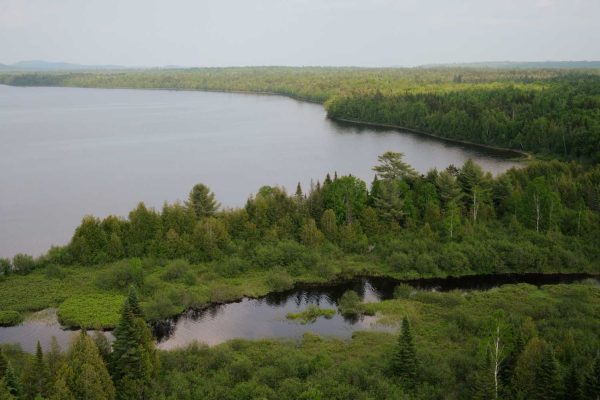
The shore of Munsungan Lake from the air
When Igor and his wife Karen took over in 1996, they began to advertise the camps as not only an excellent hunting and fishing experience, but also as a place for families to go and unplug. Since then, they have enjoyed steady business from people looking for an old-fashioned, screen-free vacation in a beautiful and remote location. Bradford Camps also played a vital role in an ambitious conservation project that took place at nearby Big Reed Pond, which is the main reason for my visit.
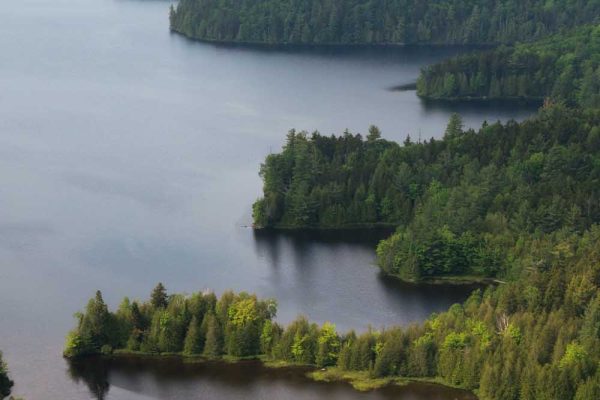
Aerial view of one of northern Maine’s many lakes
Igor and I exchange a brief hello, then I grab my bags to load into the plane. After passing my gear to him (and apologizing for the weight of my camera bag), he directs me to the seat right next to the pilot’s. I squeeze in, camera in my lap, trying to suppress child-like excitement at being in the front seat of an airplane. A few moments later Igor climbs in, shuts the door, starts the engine, and with a roar of propellers and spray from the pontoons, my first floatplane experience is underway.
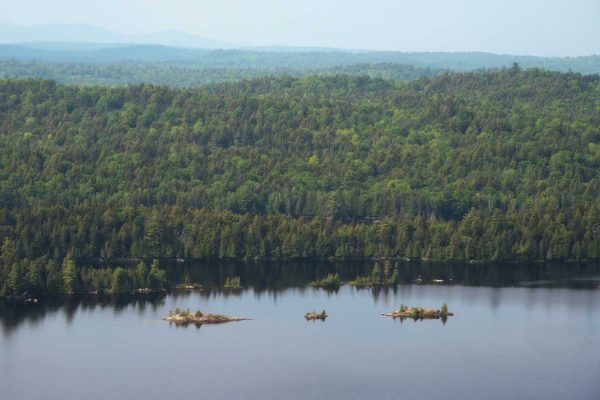
Rocky islands, smoothed by glaciers, emerge from the surface of a lake
As the lake falls away beneath us, any concerns I had about being in a plane with less cabin space than my car seem to have been left behind. I have always loved getting an aerial perspective of the landscape, and my eyes are drawn in every direction as we cruise over endless forest, broken up by lakes, streams, waterfalls, and even a few moose browsing for aquatic vegetation near the edges of ponds. It’s a cloudless day, but thick haze from Canadian wildfire smoke prevents us from seeing more than faint outlines of Katahdin and Traveler Mountains in nearby Baxter State Park as we cruise over the Katahdin Woods and Waters National Monument. From the air, Maine’s glacial history is clearly evident in the long ridges of rocks (called moraines) that cross the landscape, often jutting into lakes that fill the hollows in the landscape left by the scouring passage of the glaciers.
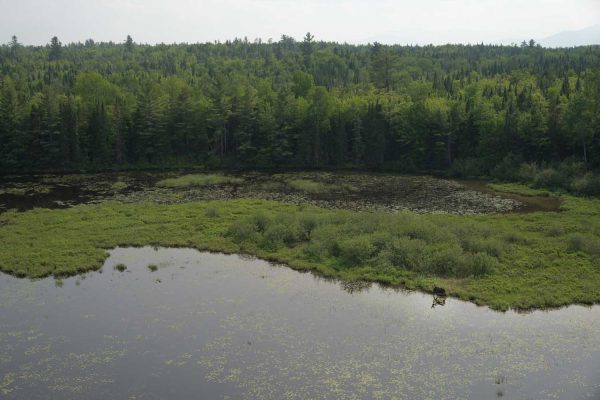
A moose looks up from its feeding at the water’s edge
As we approach Bradford Camps, Igor takes the plane on a slight detour over to a small pond surrounded by hills. From the air, it looks like any other Maine pond, with pristine water and a thick forest that grows right to the water’s edge. However, this pond, and the encompassing forest, are special. Big Reed Pond is one of only 14 ponds in the Lower 48 where a rare landlocked subspecies of Arctic charr, also called the blueback trout, is found. A striking orange color during the breeding season, this fish is prized among anglers, who travel from far and wide for a chance to catch it. Of the other 13 ponds known to have the blueback, all of which are in Maine, only 11 have natural populations (the blueback trout were introduced into the other two).
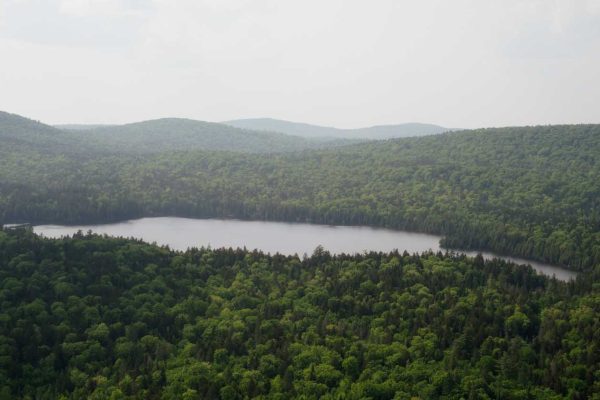
Big Reed Pond
Igor flies a few circles around the pond, pointing out the crown of a massive elm tree that can be found a short bushwhack from the shore below. The elm’s leaves are a slightly different shade of green than that of the neighboring maples and birches, allowing it to be easily visible from a distance. As much as I would love to spend the entire afternoon up in the airplane, Igor’s duties at the Camps are calling, so we make one last circuit of the pond. We pass over a beaver pond and a cedar swamp before flying over the ridge that separates Big Reed from Munsungan Lake.
Munsungan Lake, covering 1,500 acres, is much larger than the 90-acre Big Reed Pond. Even though many people visit Bradford Camps for the opportunity to fish at Big Reed Pond, Munsungan Lake is a great place to fish in its own right. It’s home to landlocked salmon, lake trout, and brook trout, and is not stocked, which Igor tells me is unusual for a big lake like Munsungan. We cruise around the perimeter while Igor points out the camp and a few features of the area, including a beach on the opposite shore from which a trail up to Munsungan Ridge originates. Bradford Camps is the only development on the entire lake, which contributes to the wilderness experience that attracts so many of its guests.
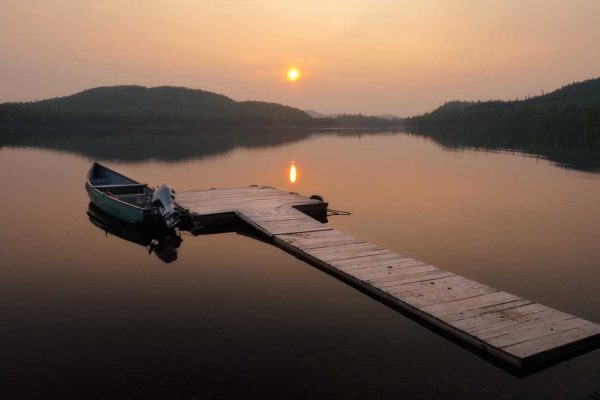
One of Bradford Camps’ docks and a smoky sunset
Igor lands the plane, and soon we’re at one of the camp’s docks. He hands me my gear (I apologize again as he passes over my heavy camera bag), and I’m shown to my cabin. During the short walk, I’m introduced to some of the camp’s other guests: a few dozen voracious black flies that are making me really regret wearing shorts.
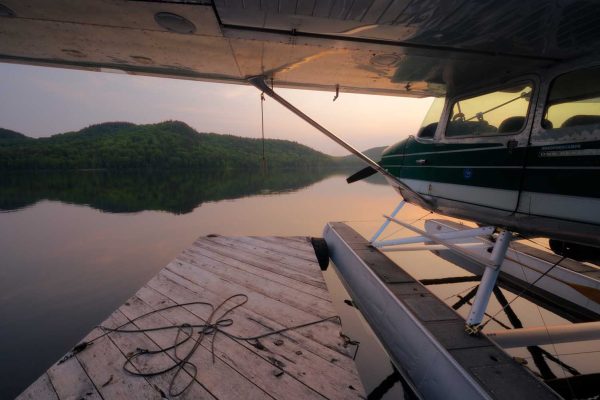
The Bradford Camps float plane and Munsungan Ridge
My cabin is nestled in the trees, with a large porch facing the lake, complete with rocking chairs. Inside, a large window (also facing the lake) lets the afternoon light in, illuminating the log beam ceiling. There is no cell service, no electricity, and the lights are wall-mounted propane lamps with boxes of matches nearby to light them (there is, however, hot water). As I stare out the window watching a pair of other guests walk by with fly fishing rods and nets over their shoulders, I almost feel like I’ve been transported back to a time before internet, cell phones, and TVs.
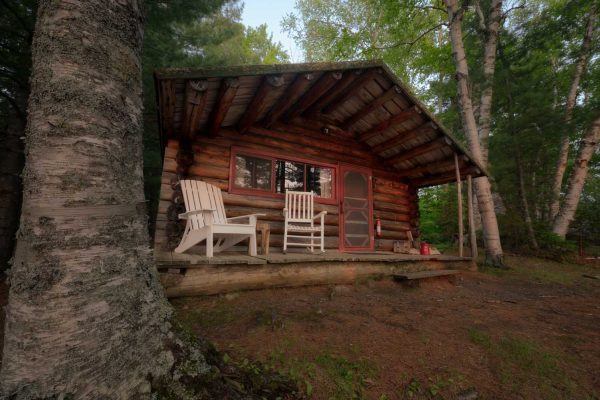
Outside of a cabin at Bradford Camps
I have a little bit of time before dinner is served, so I change into long pants and long sleeves and grab a headnet before heading out to wander around the camp. I run into Igor, and he gives me a quick tour, taking me to the kitchen, dining room, library, and even showing me the ice shed. In a stall sit large blocks of ice that were harvested from the lake over the winter, then packed in an insulating blanket of sawdust to keep them frozen all summer long. The dining room and library next door look like something straight out of a historical photo, and it doesn’t take too much imagination to picture people dressed in early 1900s outfits relaxing by the fire after a long day out on the lake.
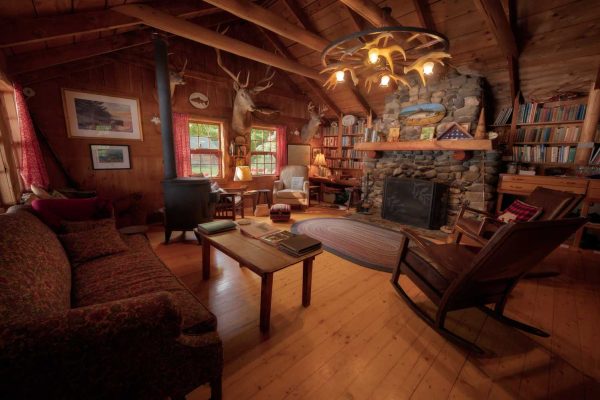
The library of Bradford Camps
Never one to pass up the chance to take a walk through the woods, I head down a trail behind the main building in search of a series of cascades that Igor mentioned in his tour. I easily find the trail and follow it as it winds its way through the forest, soft blankets of moss covering the forest floor on either side. I wander along the stream, past blooming trillium and piles of moose droppings, as the afternoon light, tinted orange by the wildfire smoke in the air, give the forest a magical glow. I easily could have spent hours there, but dinner beckons, so I head back toward the camp for a tasty grilled steak dinner before turning in.
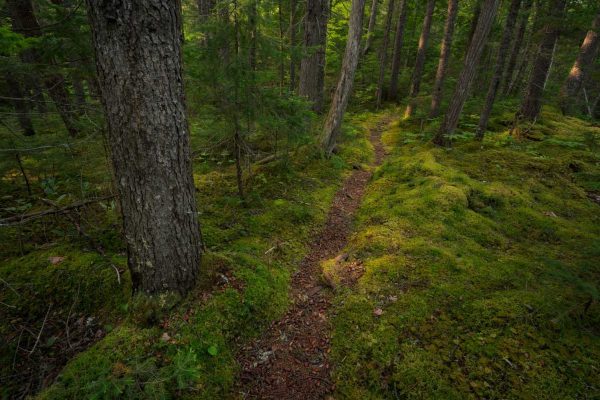
Mossy forest at Bradford Camps
The next day dawns clear and slightly less hazy. After a delicious breakfast, where options included pancakes, French toast, eggs, and bacon, I climb back into my seat in the plane, and we fly over the ridge to Big Reed Pond. After another few loops of the pond, Igor drops the plane down and we come in for a landing. He brings the plane over to a tiny dock tucked away in a small cove. I climb out and take in the view from ground level. On the shore lay a few canoes, and a small trail heads into the woods toward the two small outpost cabins that Bradford Camps leases from The Nature Conservancy, which owns the surrounding Big Reed Forest Preserve. Across the water, a few huge white pines tower over their neighbors. It’s hard to believe that this pond was recently the site of an ecological crisis that almost eliminated the very fish that make it so unique.
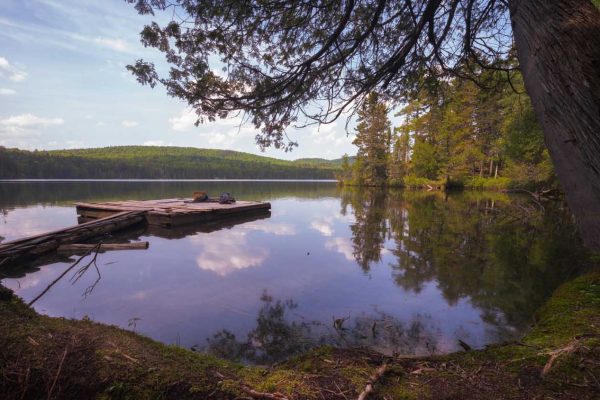
The dock at Big Reed Pond
Blueback trout were discovered in the pond in the 1950s. Reports were coming into state biologists of strange-looking brook trout that were being caught. Upon investigation, they realized that they were actually distinct populations of landlocked Arctic charr that had likely been isolated in these waters since the glaciers of the last Ice Age retreated. Unfortunately, the bluebacks in Big Reed Pond were soon to face a threat that almost wiped them out entirely: smelt.
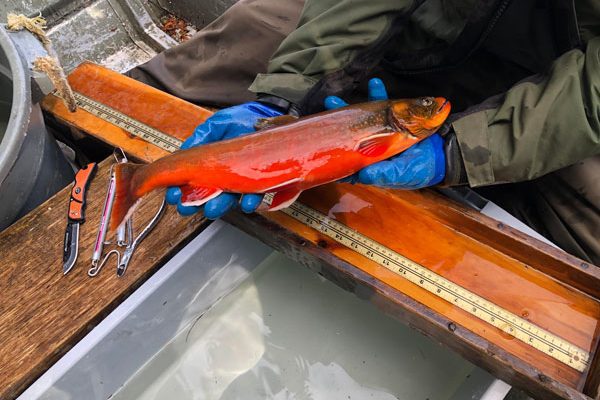
A blueback trout in breeding season (Image courtesy of Igor Sikorsky)
Rainbow smelt are a small fish commonly used as bait. They are native to Maine but can become invasive if they are introduced to waterways where they aren’t found naturally. One way this happens is when a bucket of smelt being used for bait is accidentally or intentionally dumped into a pond. They were discovered in Big Reed Pond around 1990 by guides and fishermen from Bradford Camps and quickly began wreaking havoc on the native blueback and brook trout populations. The smelt form huge schools that eat all the microscopic zooplankton that the young native fish rely on, so as the smelt populations grew, the young blueback fish died out and the populations began to crash.
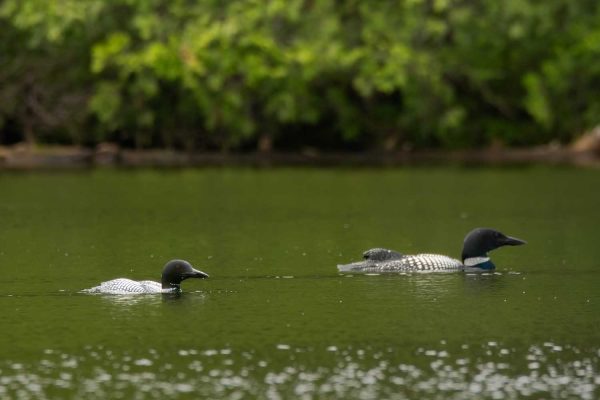
Common Loons (Gavia immer) on Big Reed Pond
Igor bought Bradford Camps in 1996 as the population crash was reaching alarming levels. Faced with the prospect of losing these populations of blueback and brook trout and their unique genetics, Igor, the Maine Department Inland Fisheries and Wildlife, and The Nature Conservancy spawned an ambitious plan to save the fish of Big Reed Pond. After years of planning, in 2008 intensive fishing efforts to try and catch all of the remaining blueback and brook trout began. Any fish caught in Big Reed were transferred to a special hatchery where they were used to create a breeding stock that would eventually repopulate the pond. Over the course of 3 years of fishing, only 12 blueback trout were caught, revealing just how close to being wiped out they were.
The most challenging part of the restoration project was ensuring that the reintroduced fish could actually survive. To make sure the smelt populations were eradicated, the drastic decision to kill all remaining fish in the lake was made. To do this, biologists decided to use the piscicide Rotenone, which is a plant-based chemical that affects the ability of fish to extract oxygen from water in their gills. In 2010, huge amounts of Rotenone, which comes in powder form, were flown into the pond by Maine Army National Guard helicopters. The National Guard used it as a training exercise to give its helicopter pilots practice carrying loads. The Rotenone was then applied to the entire surface of the pond, pumped into the deeper waters, and even poured into the streams feeding into and out of the pond to make sure that no smelt could survive. Rotenone breaks down quickly, so the biologists didn’t have to worry about any residual piscicide lingering in the pond.
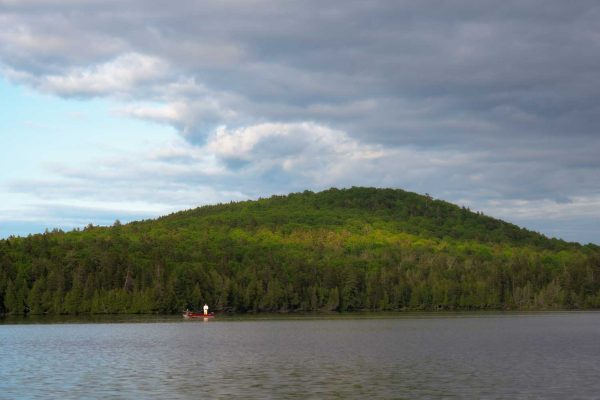
A pair of fishermen on Big Reed Pond
Once the biologists were sure the Rotenone had done its job, it was time to reintroduce the native fish. Thanks to tireless efforts by Gary Picard, the 12 blueback trout had been successfully bred, and their numbers had increased to more than 1,000 fish. Blueback trout had never been bred in captivity before, so Picard had to develop a method to successfully breed them. This required spending many very long days and sleepless nights meticulously caring for each egg. The brook trout were much easier to breed in captivity, so their numbers were much higher. Because these fish had been kept at a separate hatchery isolated from other fish, the genetics of the native strains that had spent thousands of years adapting to life in Big Reed Pond were preserved. Over the course of three years, the blueback and brook trout were flown in and reintroduced to the pond, with the last release occurring in 2013. Igor and Bradford Camps were a vital part of the process, providing housing as well as countless flights in and out of the pond to deliver supplies and transport people. But they wouldn’t know if their efforts were truly successful until they found evidence of spawning.
After a few years of anxious waiting, young blueback were finally discovered in 2017. Since then, the populations have continued to increase, and the largest pond reclamation project in the state of Maine was deemed a success. What had started off as a long shot, requiring federal permits, state permits, landowner permission, and a lot of grant writing, came together into an amazing conservation success story that helped protect a piece of Maine’s wild history.
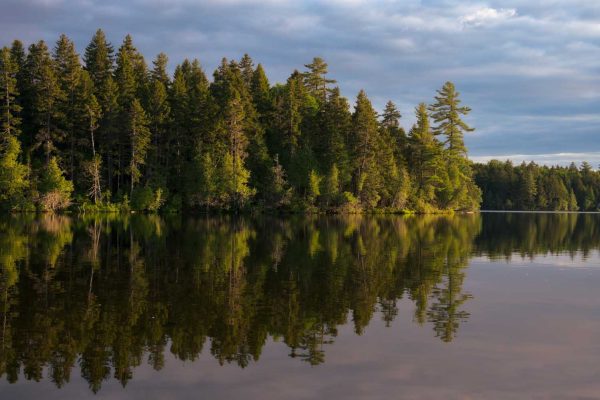
A pair of fishermen on Big Reed Pond
Many might wonder why this route was the best option. Some may say it would have been much easier to forget about the blueback and embrace Big Reed as a great pond for smelt, or to annually stock the pond with adult brook trout and blueback trout from another lake. But as Igor said to me while he was recounting the story of the reclamation, “There are really only 12 ponds in Maine that have this aboriginal species of blueback trout. There are no other ponds or waters in the Lower 48. We have this special jewel of a place in Big Reed Pond that has the capacity to hold these fish for generations and generations, if we care for it. We all decided that we would corral our resources, corral our energies, and put it toward saving that strain of blueback, and that strain of brook trout. Lo and behold, that care, that love, and that effort has paid off.”
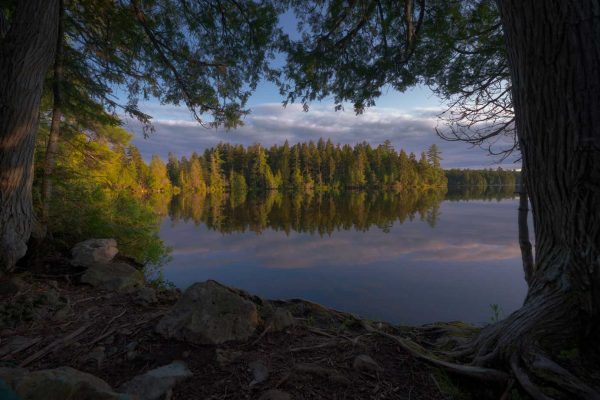
The shore of Big Reed Pond in afternoon light
My eyes travel from the shimmering water up to the trees surrounding the lake. In many ways, they are just as unique as the trout swimming far below my boat. The forest around Big Reed Pond happens to be a 5,000-acre patch of virgin, uncut, old-growth forest, the largest contiguous old-growth forest east of the Mississippi and constitutes 75 percent of Maine’s total old growth. I’m itching to get in there and wander through trees that have never seen an axe or chainsaw. My contemplation of the fish complete, I turn the canoe and head back toward the dock to see what hidden wonders are waiting to be revealed behind the trees standing sentinel at the water’s edge.
Continues in Part 2: Big Reed Forest Preserve
A video produced by Maine Department of Inland Fisheries and Wildlife showing the reclamation process can be viewed at: https://youtu.be/rh0VudWLeaw
–Nathaniel Child











Thank you for this wonderful account of preserving our precious resources.
I’m 53 and a native of Maine. A real native whose ancestors was here since the last ice age and I never knew that artic char was still in Maine. Very nice article.
Very interesting and well written. I’m so glad that the very hard work of blueback species restoration was undertaken and that they are surviving.
I have very fond memories of fishing Munsungan with my now passed father. It is a truly amazing place
Thank you for creating a space where I can escape and immerse myself in positivity.